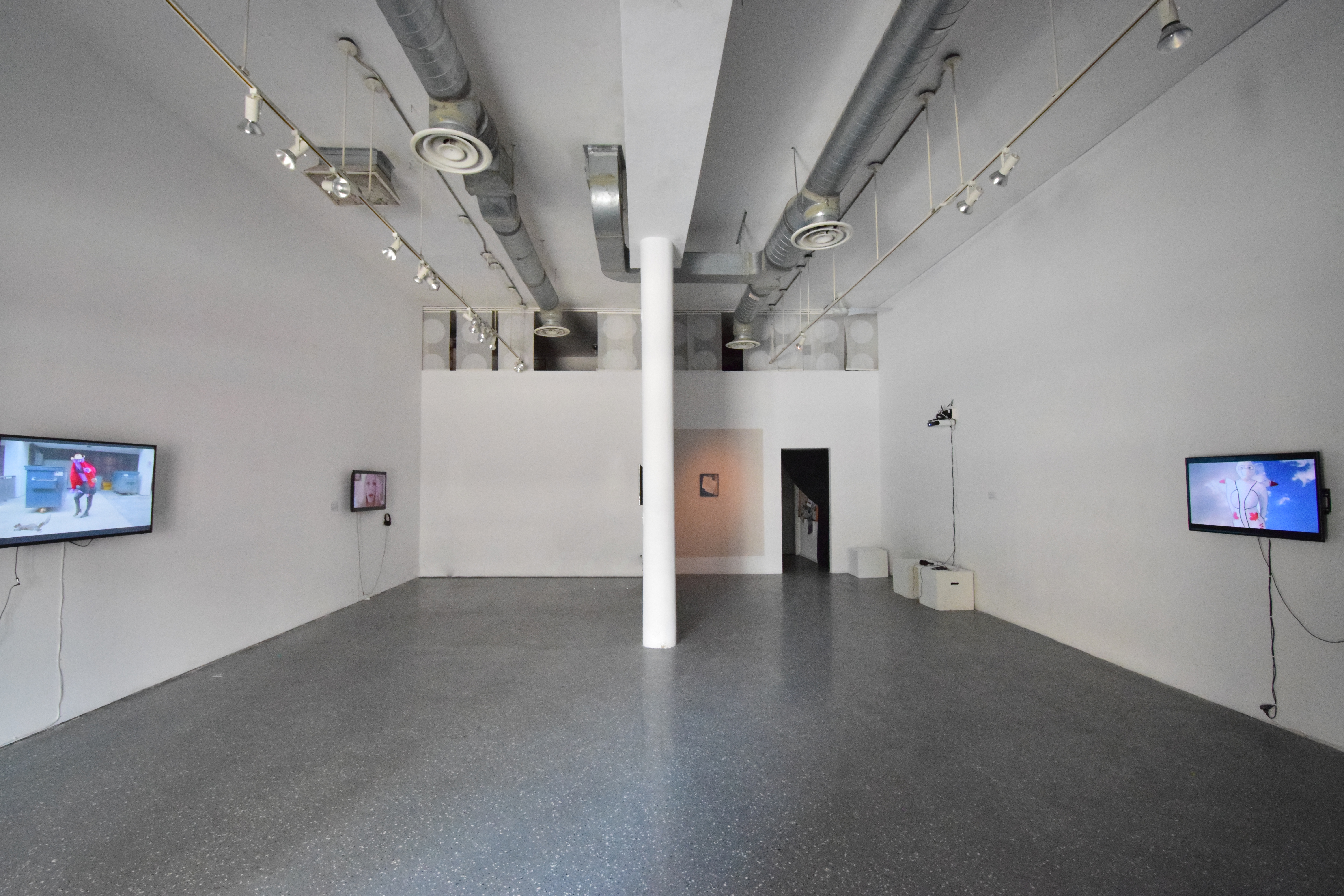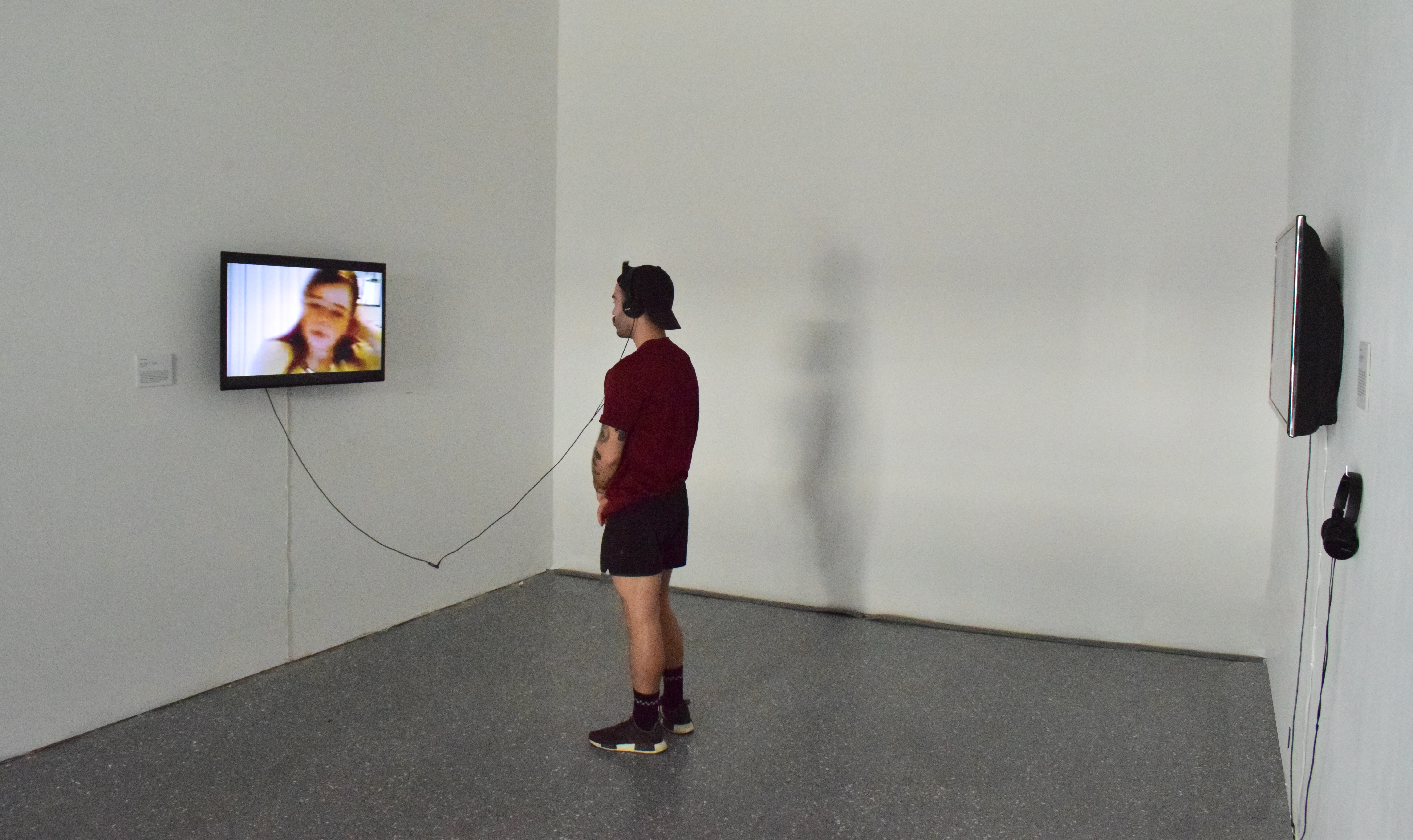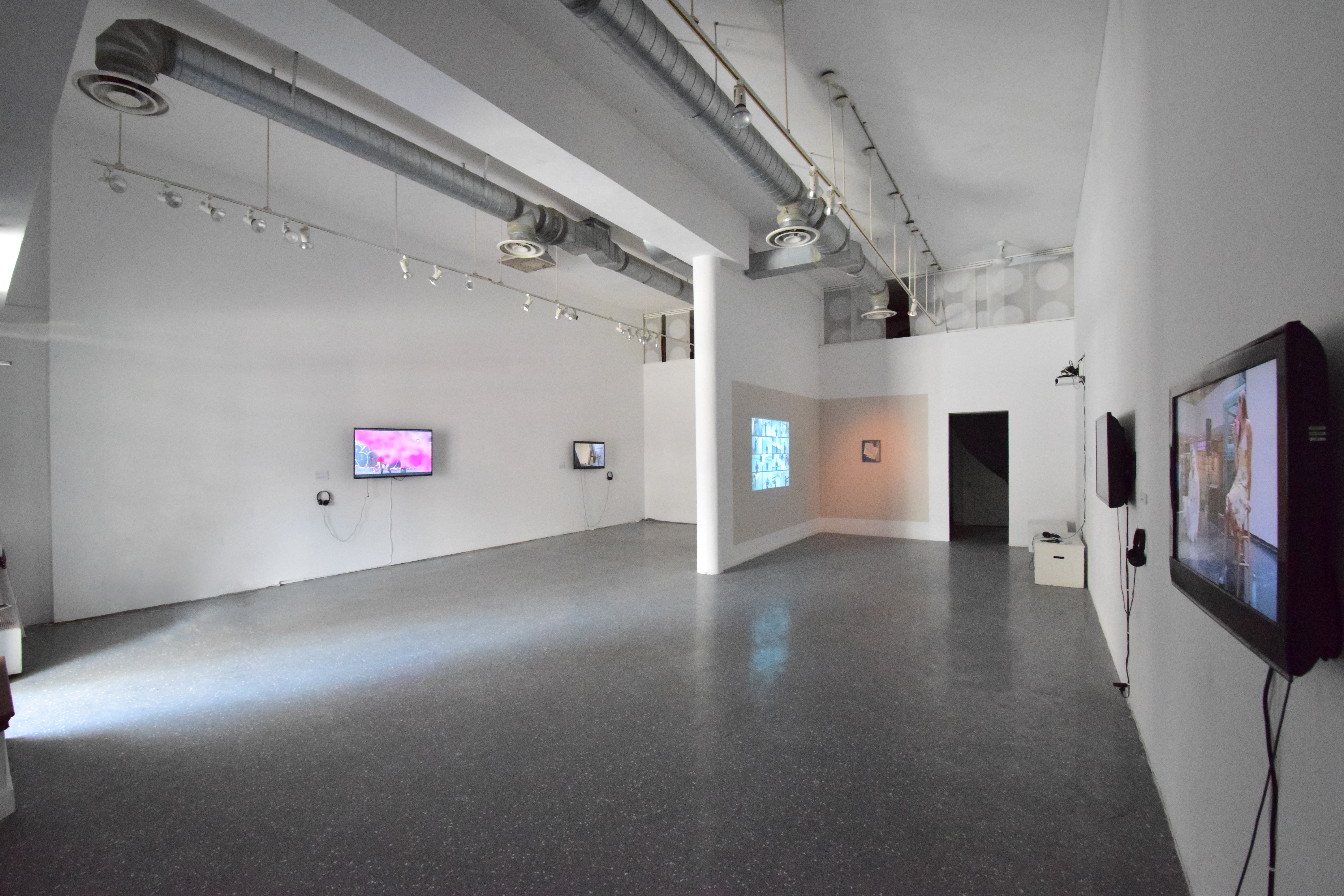In Conversation with the Curator: I Can Boogie but I Need a Certain Song at Artcite Inc.
June 2 - July 13, 2019
Interview, July 13, 2019 by Luke Maddaford
Off centre’s Luke Maddaford sat down with Artcite Inc’s Executive Director Lucas Cabral to talk about the exhibition he curated, I Can Boogie but I Need a Certain Song. The exhibition, featuring video work by Amie Siegel, Benny Nemerofsky Ramsay, Bearbara, Maya Ben David, and John Greyson, explores music as a material and language in artmaking. The exhibition ran from June 2 - July 13, 2019 at Artcite Inc. in Windsor, ON.

Photo courtesy Artcite Inc.
Off Centre: So, the exhibition. Do you want to start by giving a little bit of information about it?
Lucas Cabral: Sure. So, “I Can Boogie but I Need a Certain Song’ looks at how artists use music as a form of language that comes with predetermined understandings and connotations, that ensures an ease of understanding..
OC: Like an entry point for a viewer that maybe isn’t used to art language.
LC: Yeah, there’s a shared experience that is associated with certain songs - or a certain kind of emotional connection. The relatability is there and then you can build off of it, or diverge from it in order to show what you want to show. But at the same time, artists are people reflecting the way that people in general do this. They use music to proclaim or to demonstrate emotion to others about themselves in the world.
OC: Even to show a bit of their identity to somebody right?
LC: Yeah, absolutely
OC: That’s cool. Can you talk about the title for a bit…
LC: Yeah
OC: ...cause I really like it. And I think it’s funny and smart.
LC: So, it kind of runs parallel to the way I make a lot of my own work as an artist, borrowing from song lyrics, metaphors, figures of speech, and playing with them to point out something that is there, but not necessarily the most obvious. And as I’ve been living my warmer weather life and getting into disco and Pride, the song, “Yes Sir, I Can Boogie” by Baccara has been coming up over and over again, and within it the singer says, “I can boogie but I need a certain song/I can boogie all night long” So boogie-ing is the engagement or the connection, but the lyrics also acknowledge the personal specificity required to trigger it. It was a nice way to borrow from music to name the exhibition while also pointing to what’s actually happening in a lot of the work itself.
OC: Cool, let’s talk about the work.
LC: The exhibition includes, Amie Siegel who is based out of New York, Bearbara who is a Canadian artist, Benny Nemerofsky Ramsey who is Canadian based now in Scotland, John Greyson, and Maya Ben David from Toronto.
OC: It’s a very wide range of artists, who have very different practices, so it’s really interesting to see them all in one show.
LC: I wanted to show that this is a strategy that’s used to communicate universally, not just specifically about music or the production of music, it’s getting into all kinds of interests. Maya Ben David has two works in the show and both of them are fairly different. One of them is from a series, or an ongoing body of work where she is developing cosplay characters, and that’s Air Canada Gal. In that video she takes the selloffvacations.com jingle and slows it down and when she does it becomes kind of sexy and alluring and sultry. So she is using music to communicate the identity of this character they are creating, but also at the same time pointing at this romanticization or glamourization of travel and world travel and how ooh-ah-ah travel is, right? Also looking to advertising, all the sexy images of people sprawled out on beaches and the sun beating down and all of that. Applying those tropes to this character through music paints the bigger picture of what this character is. Simultaneously reclaiming, or using it in a tongue and cheek way, to reclaim what she faces online as a woman who is involved in this culture which is a lot of sexism, which is a lot of misogyny. That piece does a lot.
OC: Yeah, that piece is one of my favourite pieces in the show. And I’ve shown it to people and talked to other people about it before and they are on either end of it. They either love it and are totally on board with it, or they have no idea what’s going on and think it’s the weirdest thing ever. So, I guess with that kind of work, it’s interesting to see it in a smaller city, and in a smaller space. I think that you are less likely to get people who are going to be on board with it in a city like Windsor. So, I’m kind of interested in how you feel the exhibition operates in a region like Windsor? Why is it important to put together an exhibition like this here?
LC: I think that’s a hard question to answer, because I’ve only been in Windsor for a few months now. I’m not really sure. But what I think is interesting and what I continue to find satisfying with people coming through the exhibition is I can hear them laugh, I can hear them chuckle, I can hear them sing along or hum along as it’s going on. And it’s a different way, it’s not necessarily what people expect when they come into an exhibition.
OC: It’s maybe a little bit less serious than they expect.
LC: it eases you into it and the humour aspect of it allows you to kind of relate to it more.
OC: It offers another entry point, and there is quite a bit of humour in this show. Like, I think almost all the pieces have an element of humour. Which I think is really nice. Bearbara’s video as well is just like, so funny, but it’s a very serious topic. And I think it’s interesting to put those kinds of things in an exhibition, where they’re not necessarily going to be taken seriously at first, but it’s going to offer somebody another way to engage with it, and maybe they will give it a little more time because they are being entertained as well.

Photo courtesy Artcite Inc.
LC: I think it’s kind of a bit of a back and forth in terms of... we are seeing artists using music to communicate aspects of their identity individually, but on a grand scale, it is everyone. So if you look at the Amie Siegel works, My Way 1 and My Way 2, each one pulls videos from YouTube. The one on the left, young kids, mostly girls singing a track from High School Musical, on the right, typically older men doing My Way by Frank Sinatra. And these things that are large emotional gestures, big public things that have been put online for everybody to see, become very very intimate in this viewing. In combining these clips together, personal becomes universal as clips of performances of the song are combined into 12 minutes of the people all singing the same thing. What is perceived as being this unique independent gesture, when they are all brought together like this, is actually not. Your conviction to sing this song and identify yourself by it is something that everybody else is doing. All these people have done the same thing. So what actually becomes more telling in these snippets, in these portraits, are the things in the background: posters, the pictures, what shirt are you wearing?
OC: One of the things that I really like about that piece is, I find that people posting covers that maybe aren’t even that good online is a really vulnerable thing to do and putting them all together creates this shared vulnerability where it’s no longer just you bearing yourself out online, it’s a thing that everybody is doing and it’s not as scary, it’s more of a cultural phenomenon.
LC: It’s in the way the monitors are facing each other, too. We are made aware that it’s something that develops with us. Like it’s not a juvenile gesture done because you don’t have the language or skills to articulate how you feel. You have this older group who are also doing the same thing and with time and money they invest in better audio equipment. You can see it, they have mics on stands. Where in My Way 1 there’s posters of High School Musical or My Little Pony, on the right in My Way 2, there’s Heineken signs, lava lamps, one guy has a gun hanging up in the background. So shared by these very different types of people with different interests is this idea of using music to effectively communicate what you feel, or what you’ve been programmed or told to feel.

Photo courtesy Artcite Inc.
OC: Definitely. Do you want to talk about Benny Nemerofsky Ramsay’s work?
LC: So Benny’s work was really interesting to me durationally. The video was produced in 2002, and it was paired with a letter that was sold to collectors and sealed. The letter was written to Madonna and explains how through making this video and her music, he was able to kind of understand more about himself and this new experience. There’s an interview online where he talks about when he had heard the song when he moved to Berlin from Canada after a heart break and was at this party and was all, “fuck, I hate Madonna, she’s evil incarnate, but this song is telling my story”
He’s talking about how these things are produced to be relatable and be connected to, but also he’s very aware of the opposition. For this show, the framed work replaces what would normally be the sealed letter. So all these years later, his connection with the work and his connection with the song has changed, shown to us through how the work has changed. The letter which was kind of a personal thing between him and Madonna, he has now taken excerpts of it and made it public. And the first couple lines, “Your lyrics became a tool through which to understand my own experiences...”
OC: I think you could apply that to the whole exhibition.
LC: Yeah, and in terms of feeling loneliness and feeling seen, performing this for 16 individual security cameras. Madonna has never seen him, she doesn’t know him but sang this song, produced this song so particularly that it applied so specifically to him that he feels seen. There’s a voyeuristic part to it. But also, within that he is one of many who has also shared that same experience, right? So it’s doing something not so dissimilar from what Amie Siegel is doing. But in a personal way, looking inward, whereas Amy Segal is looking at this outward trend, spotting what people are doing. Does that make sense?
OC: Yeah, I think it does. Should we talk about John Greyson?
LC: Yes. So this piece and the Bearbara one function a little bit different for me in the way I’ve been thinking about the exhibition. I’m interested in how these interventions into song provide space for personal inflection, personal style, right? But also how music is a storytelling tool like what we saw with Benny.
Greyson hasn’t really spun off a song, he’s taking an existing story and applying music to it, he’s reclaiming that story and using music as a way to do so. Similarly with Bearbara who makes music as Bearbara because she feels that her messages of consent are not received when she is not Bearbara. Somehow as this 8-foot tall purple bear, she is taken more seriously and her message is taken more seriously. So at the tail ends of the exhibition this strategy of interrupting the space instead of the song is different. Thinking differently about how the performer can engage a space and audience.
OC: This one, I also feel is much more embedded in a larger social issue, or maybe something more people would have heard about or be aware of than something like Amie Siegel’s work, or especially Maya’s work. I guess it feels like much more of an established commercial work than some of the other ones. And I think that’s very interesting in that it’s another way of engaging with people. When you have this kind of commercial production of something it gives it clout and people are going to take it more seriously.
LC: Absolutely. And getting more into using music and in this sense, this genre of music, comes with it’s own connotations. Right? It’s an opera, you don’t make an opera about your cosplay character.
OC: Maybe you should.
LC: Well yeah, but using storytelling and this specific mode of music storytelling to position this story is seen as this classic and deconstructing all of that classic-ness through opera and through the visual symbols as well.

Photo courtesy Artcite Inc.
Maya Ben David’s take on the John Denver song in Serenading my Apartment reflects our eagerness to connect with music. She takes this John Denver song which is comparing his love for his then-wife to a walk in the rain, a mountain covered in flowers, all these grand metaphors, and as she sits in the mall and makes this very public, grand, gesture of love and affection for her popcorn ceiling in her apartment, she grasps at straws to actually make it apply to her life. So, she’s like “I’ve never been on a mountain of flowers, but I’ve seen the sound of music and it was this and that and whatever da da-da da da-da da”. All of a sudden you are way lost in this dark hole of trying to make this sound really, really, connect with you. At the end, a clip of Denver reflecting on the song after splitting from his wife saying, “I wrote this song for Annie, but this song is for our children, it’s for this, it’s for that, it’s for this person, it’s for this” and it exposes how widely music actually has to be produced in order to make that connection. You think about the ways that music resonates through you and for what reasons.
OC: Do you have anything else to say about the show?
LC: I’m sure I will after you leave.
OC: I think it’s fantastic. It’s really nice to see all these artists in Windsor. I feel that they aren’t necessarily artists that I would expect to see here, or together in one exhibition, but I think it turned out really well, and it’s nice.
LC: Thank-you.
